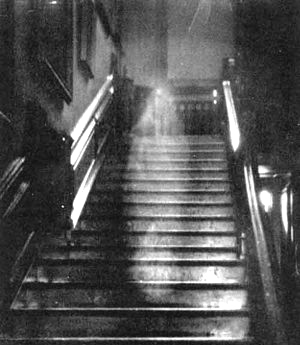|
WHISTLING SHADE |
The Brown Lady—A True Ghost Story
Every town has its ghost stories. In the Twin Cities we have the Wabasha Caves, Forepaugh’s and First Avenue. But those searching for more (pardon the pun) substantial evidence of spirits might want to look further abroad—for example an old manse in Norfolk, England, called Raynham Hall. It is said to be haunted by the “Brown Lady,” thought by some to be the spirit of Lady Dorothy Walpole, who later became the Viscountess Townshend. Ghost sightings at Raynham span centuries, with several credible written accounts, and what may be the most famous ghost photograph in the world.
First, a little background. Lady Dorothy, born 1686, was a member of the illustrious Walpole family. Her father was a member of Parliament, and her brother, Sir Robert Walpole, became Prime Minister. The family is best known now, however, for her nephew Horace Walpole, author of the gothic novel The Castle of Otranto. In any case, Lady Dorothy Walpole was brought up in wealth and luxury, and is said to have fallen in love with a real live viscount, Charles Townshend. But her father, who was Townshend’s guardian, forbade the marriage so that he would not be seen as unduly influencing the young nobleman. So Townshend married Lady Elizabeth Pelham instead. His wife died, however, in 1711, leaving him free to marry his beloved Dorothy. It seemed that all their dreams were coming true.
Dorothy, however, had not been idle in the intervening years. She had become the mistress of one Lord Wharton, a dissolute ne’er-do-well who had to leave the country rather suddenly because of debts. After they had been married some years and started a good-sized family, gossip of the affair began to reach Charles Townshend—whereupon the hot-headed lord allegedly locked his lady in one of rooms at Raynham. There she remained a prisoner, separated from her children. Lady Dorothy Walpole died in in Raynham in 1726—officially of smallpox, though there were rumors of a more violent death.
Fast forward about a century. Various visitors to Raynham hall—including, apparently, the Prince Regent himself in 1815—reported being frightened out of their aristocratic wits by a lady in a dated brown dress walking the halls at night. This personage seemed to inexplicably appear and vanish, and bore a strong resemblance to a portrait of Lady Dorothy that hung in a bedroom.
A certain Colonel Loftus, going up to his bedroom in the company of a friend, saw the “Brown Lady” on two successive nights, and remarked on her empty eye sockets (a few of the servants immediately gave their notice). The novelist Frederick Marryat, a friend of Dickens, saw the ghost in 1836. Apparently believing the ghost sightings were due to smugglers at Raynham, Marryat slept in the bedroom where Dorothy’s portrait hung, a loaded pistol under his pillow. One night, walking down the dark hall in the company of two nephews of the family, he saw someone with a lantern approaching. Being a Victorian in only his nightclothes, and thinking it was a woman going up to visit the nurseries, he withdrew behind a bedroom door. As the lady came down the hall, he recognized the dress and features of the Brown Lady, who stopped at his door and “grinned in a malicious and diabolical manner at him.” Mr. Marryat then got a shot off with his ever-handy pistol, and the ghost vanished (he later found his bullet lodged in the opposite door).
After this spate of hauntings Raynham Hall seems to have quieted down a bit, though there was one sighting by Lady Townshend on the stairs in 1926. Then came the Country Life affair.

Still published today, Country Life is a British weekly magazine celebrating the British countryside—chiefly its aristocratic pleasures. In 1936 Country Life did a feature on Raynham Hall, and dispatched a photographer, Captain Hubert C. Provand, to shoot some photos. Provand and his assistant, Indre Shira, were photographing the grand staircase when the Brown Lady paid another visit. Here’s what happened, as Shira recalled it:
"Captain Provand took one photograph while I flashed the light. He was focusing for another exposure; I was standing by his side just behind the camera with the flashlight pistol in my hand, looking directly up the staircase. All at once I detected an ethereal veiled form coming slowly down the stairs. Rather excitedly, I called out sharply: 'Quick, quick, there's something.' I pressed the trigger of the flashlight pistol. After the flash and on closing the shutter, Captain Provand removed the focusing cloth from his head and turning to me said: 'What's all the excitement about?'"
The excitement was just beginning. When Provand developed the photograph, a ghostly image could be seen descending the stairs. This picture, which may be the most famous picture of a ghost in the world, appeared in Country Life, and a year later, in a Life magazine article about haunted Raynham.
Was the photo a hoax? Possibly, though faking a photograph in 1936 involved more than messing about in Photophop. Grease could have been put on the lens, or perhaps a double exposure was made. But Captain Provand was a reputable London photographer, and his story and Shira’s agreed exactly. And Country Life is hardly the National Enquirer. Other explanations should at least be entertained. Was the Brown Lady some strange optical phenomenon in the house? Or some kind of time-space overlap? Or (god forbid) was she an actual, real-life ghost? 